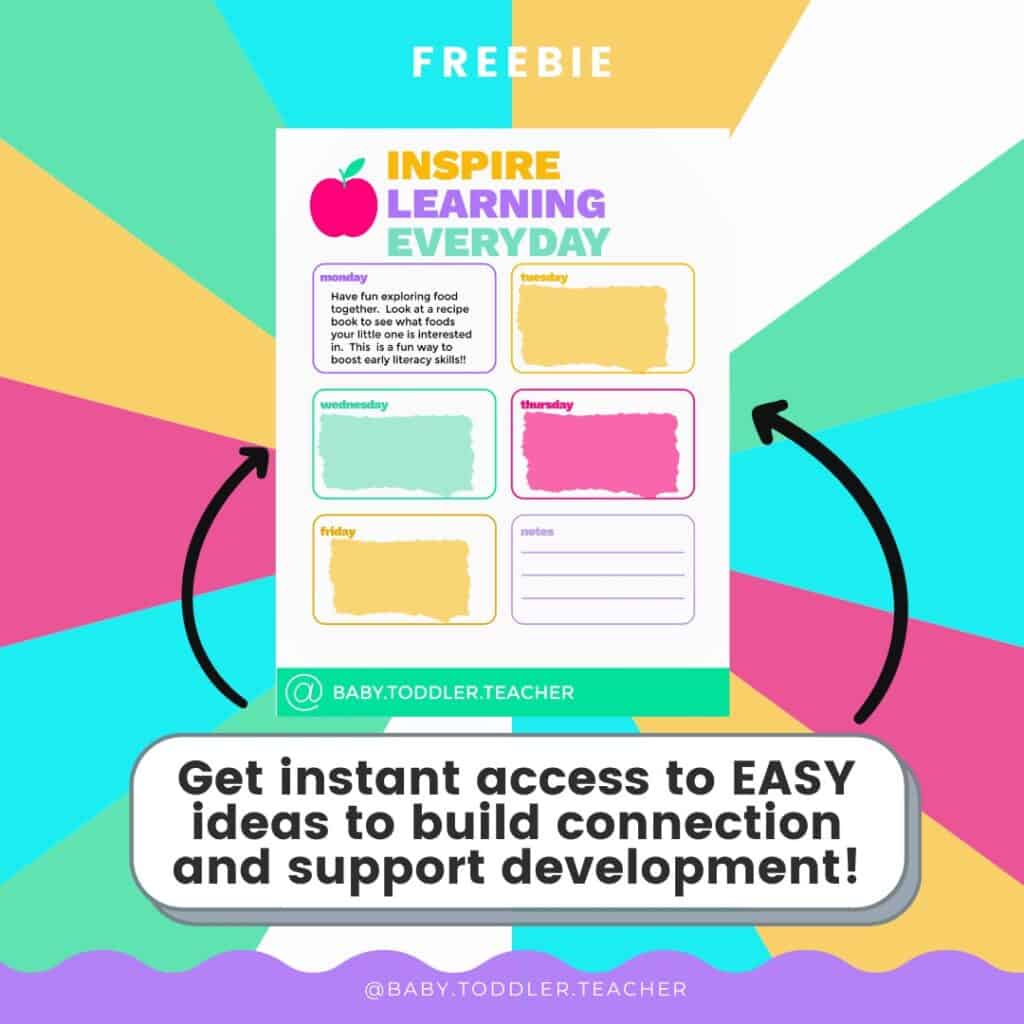Your little one just had a birthday and is now in the transition from baby to toddler.
With a whole new skill set you may be wondering what the best activities for 1-year-olds are?
As an early childhood teacher, I know how important it is to have a variety of activities and ideas to keep your little one busy!
In this post, we will talk about the development that is occurring in months 12-24 and some simple ways to encourage it through play and activities.
These developmental activities for 1-year-old children do not require many supplies and are easy to set up.
I have broken down the skills that typically happen between 12-24 months by each developmental domain below including:
- Intellectual Development
- Social Development
- Fine Motor Development
- Gross Motor Development
- Language Development
- Self Help Development
Remember that all children are different and may develop skills at different times which is typical.
The skills listed below are for children 12-24 months.
That is a large age range so do not expect your child to have all the skills listed by 12 months…or 15…you get the idea!
After the skills set there is 1-year-old learning activities to work on that domain.
This post also contains information about:
- Book Activities for 1-Year-Olds
- Where can I find the best activities for my one-year-old?
- Best Toys for One-Year-Old Activities
- Safety Tips for 1-Year-Old Activities
I have also included a free printable developmental checklist for children 0-36 months so make sure you grab that! Enjoy!
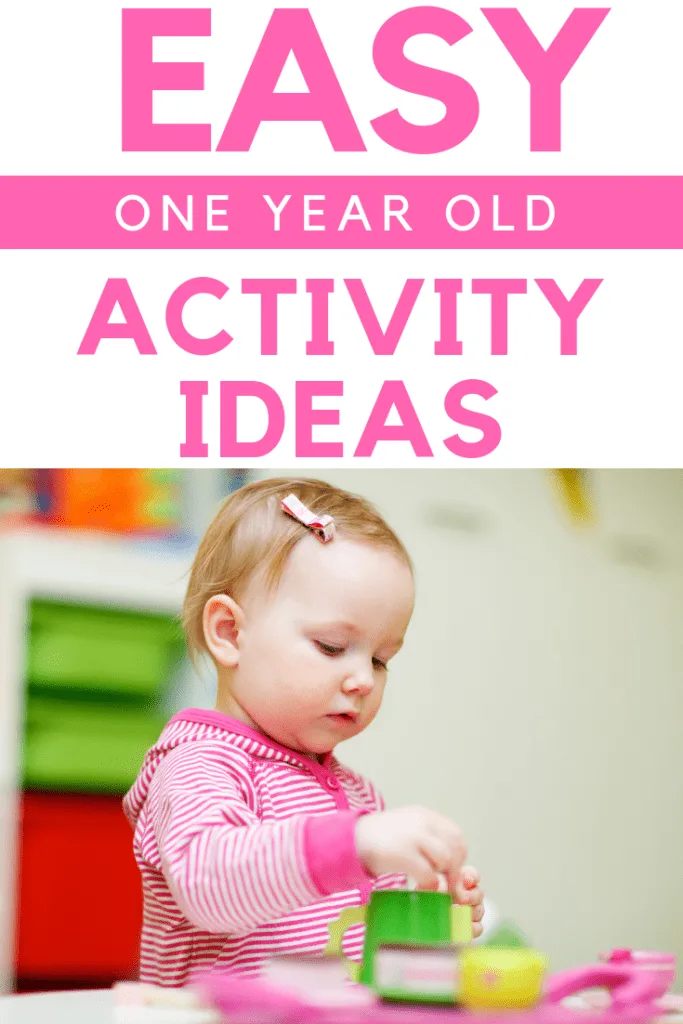
(This post contains affiliate links. To read our full disclosure policy click here.)
The Best Activities for 1-Year-Olds to Encourage New Skills
12-24 Months Intellectual Development
So many skills are coming together for your little one in the upcoming months.
Your toddler will start grasping simple academic concepts such as colors and following directions.
- Understanding colors
- Pointing
- Turning pages in books
- Solves simple problems
- Identifies body parts
- Following simple directions
- Matching objects to pictures
- Sorting objects
- Completing simple puzzles
- Using playdough and paints
If you want a more detailed checklist so you can keep track of what your child is doing be sure to go to the bottom of the page and grab your free one to print off.
Activities that encourage cognitive development can take place during playtime and daily routines.
Book play is an important part of cognitive development and many skills can be worked on while flipping through age-appropriate books (like this one.)
Intellectual Activities for 1-Year-Olds
After reading through the list above you should have some ideas of what skills you can work on through play and 1-year-old development activities.
When working on cognitive skills choose activities that require problem-solving skills such as puzzles (like these.)
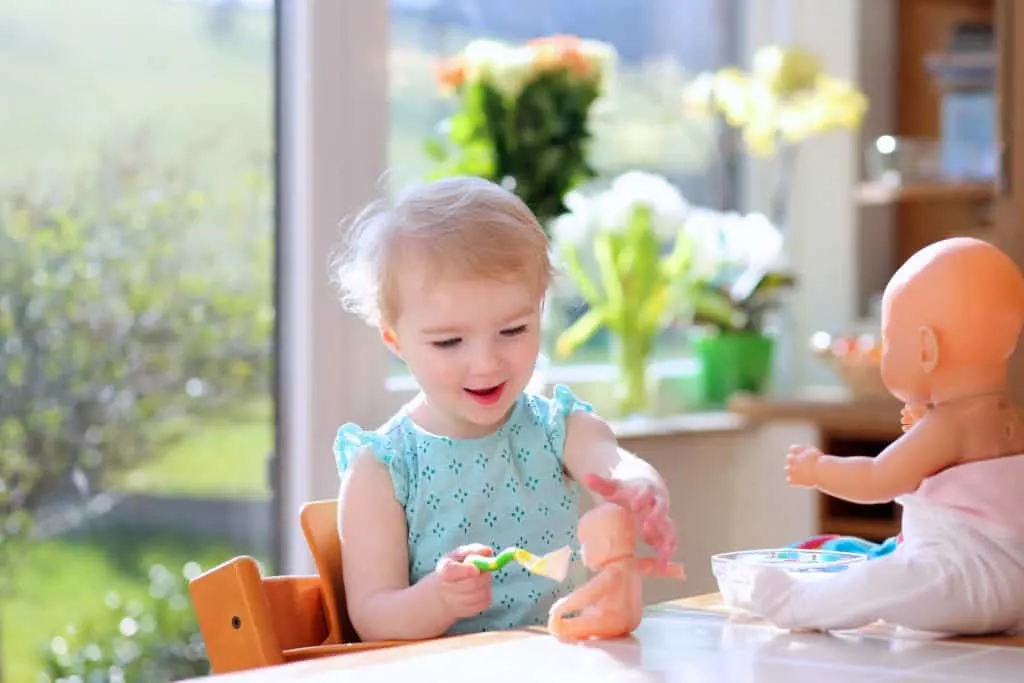
Bathing Baby Dolls
Have your little one wash their baby dolls.
You can either “pretend” to wash them using just a washcloth or use actual water if you choose.
Label the body parts while you wash them.
This is a great way to build your toddler’s understanding of language.
You can also role-play out new concepts for your toddler such as sharing.
See if they can follow simple commands such as washing their arm.
Sort Cars by Color or Size
If you are looking for a different way to play with cars try sorting them.
You can either use size or color.
Start with just a couple at first so that they can grasp the concept.
You can also practice this skill during clean-up time by having them pick up all the red ones, then blue, etc.
You can read more about teaching match to toddlers here.
Play a Matching Game
Practice matching by including your toddler in laundry time.
When you are folding socks see if they can pick out ones that look the same.
You can also do this with their toys.
See if they can find two blocks that are the same color.
If they have animals can they find the two that look like?
Get creative and see what they can match in the playroom or around the house.
After they have mastered matching objects and toys you can move to matching pictures.
I created this set of vocabulary cards that work great for matching games and are also great to use when communicating with your toddler.
You can download them immediately and print them from your computer.
12-24 Months Social Development
Your child may have some words but may find it difficult to use them at all times.
They still may be relying mainly on gestures to express their needs and wants.
Social play is really starting to emerge!
They are starting to include you in their play more and are parallel playing with others.
Don’t be too concerned if they only stick with one toy for a short period of time before moving onto something else.
Attention spans are short at this age and there is just so much to do!
- Acts impulsively
- Plays ball cooperatively
- Shows preference for certain toys
- Needs routines and rituals
- Enjoys being center of attention
- Gives parents hugs and kisses
- Imitates real life activities such as housework or chores
- Expresses jealousy
- Engages in parallel play
- Plays alone for a few minutes at a time
- Attempts to help others in distress
Social Activities for 1 Year Olds
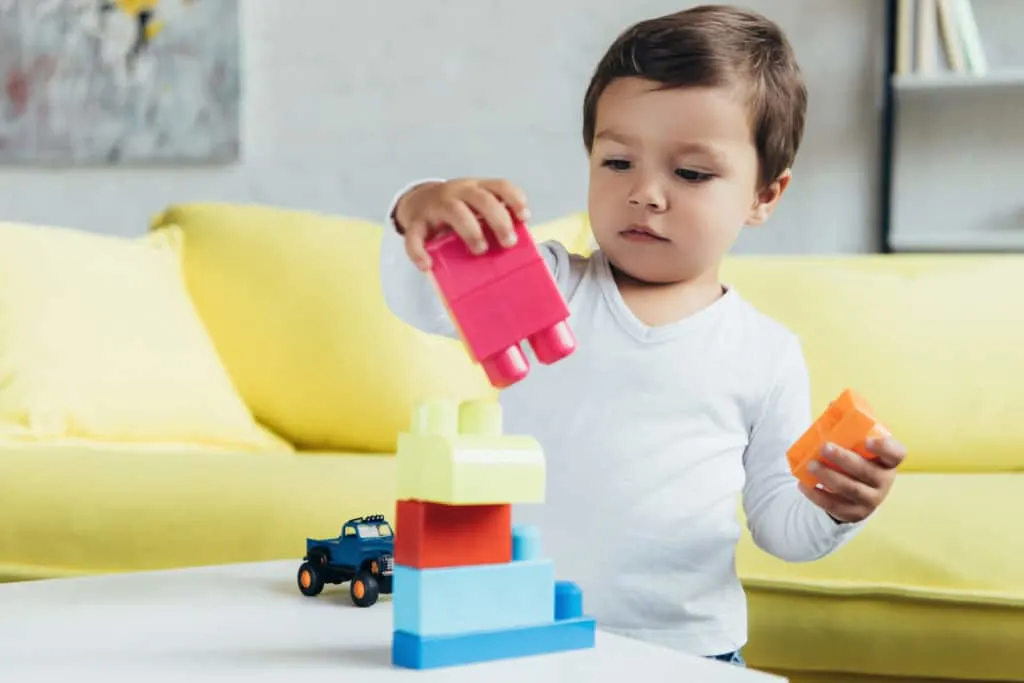
Build Something Together
Don’t expect to build a huge mansion with your toddler but you can start to try and play cooperatively.
Take turns stacking blocks to make a small tower together.
Pretend to Be Animals
Pretend play is just starting to evolve.
You can do any form of pretend play and pretending to be animals is a simple way to get started.
Your little one is just starting to learn animal sounds so it is a perfect opportunity to practice that as well.
Have fun barking like a dog or meowing like a cat. You can use stuffed animals or animal puppets (like these) if you want.
Ball Play
Ball play is often thought of as an activity for gross motor development.
Which it is.
However many social skills can be built into ball play.
Roll the ball back and forth with your little one.
This allows both of you to be engaged in the same activity together and play cooperatively.
You can even start to introduce phrases like “your turn” and “my turn” which you want them to be familiar with as they play with other children.
It may be a while before they understand those words, but this is a fun way to introduce the concept.
Set Up a Play Date
One of the best ways to encourage social skills in your child is simply by giving them the opportunity to interact with other children.
This could be a cousin or friend.
If you don’t know anyone with a one-year-old just go to places where you know kids hang out.
Hit up parks and playgrounds to start with and make some new friends.
When I first became a stay-at-home mom we had just moved to a new city and I knew no one.
I was able to find a local group of moms that got together which was so helpful!
Meeting other parents at the local library can be a good place as well.
12-24 Months Fine Motor Development
- Marks paper using crayons
- Puts objects into containers
- Scribbles spontaneously
- Builds small towers with blocks
- Folds paper
Fine Motor Activities for 1-Year-Olds
Your toddler is starting to gain coordination when using their hands so you will want to incorporate learning activities for 1 year olds that support that.
This year they start using their hands for functional play such as building with blocks or maneuvering cars.
Your child is also starting to be able to imitate fine motor actions such as scribbling on a piece of paper.
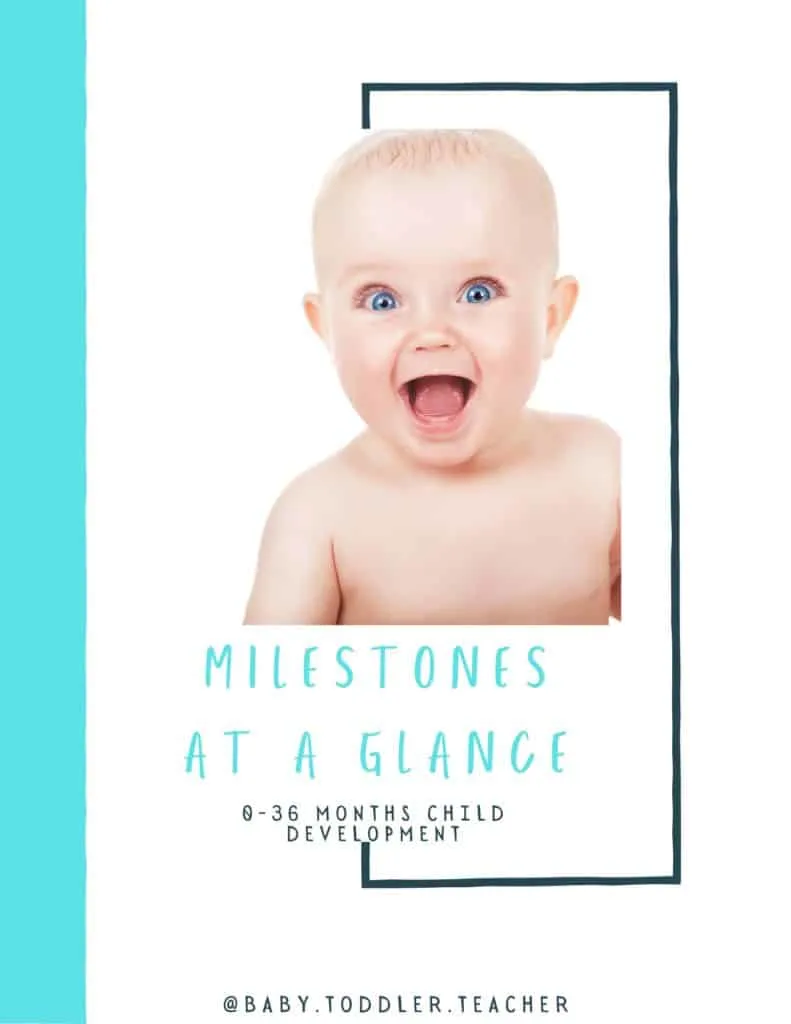
Grab your FREE Milestone Guide HERE.
Play with Play Dough
When children are past the 1 year mark it can be a great time to introduce play dough!
Always make sure you supervise your little one closely with it, especially if they are still putting non-edible items in their mouth.
Fine motor skills are worked on with play dough naturally, so you really don’t need to do anything special…just let them play and explore!
You can model different ways of playing with the dough such as rolling it into a ball or log.
Make flat pancakes together or poke holes in it using your fingers.
You can buy a play dough tool set (like this) so that you can have a knife to chop it or grab some cookie cutters to make interesting shapes.
Don’t have any play dough on hand? This is the recipe I have been using to make mine (click here to check it out.)
Another fun option is to use play dough mats to add some structure to the activity.
You can grab the ones I created HERE.
I have my son help me get the ingredients mixed together and ready to cook.
Another simple activity to do with your little one!
Coloring and Scribbling
Grab a large piece of paper and let your little one scribble with crayons.
Not only does this encourage fine motor skills but it also boosts early literacy skills as well.
Children may not have a dominant hand yet for writing and coloring so you may see them switch from one hand to the other.
This is very normal as children don’t always get a dominant hand until closer to age 2 or 3.
Instead of handing your child a crayon, lay it on the table and let them choose which hand they want to draw with.
You can model drawing skills for them like taking a crayon and making dots or straight lines.
If it is a nice day out…take this activity outside!
Grab some sidewalk chalk and decorate your driveway with bright colors.
Draw a hopscotch and show your child how to jump in the blocks.
Draw a straight line and walk across it like a balance beam to get some gross motor skill practice in as well.
Scrunch Paper
One of my son’s favorite things to do when he was younger was to get the mail and scrunch, tear, or rip up the junk mail!
This is a fun way to work the muscles in their hands while having fun.
You can do the same things with unwanted newspapers and magazines.
Turn it into an early literacy activity by looking through the pictures before the shredding begins.
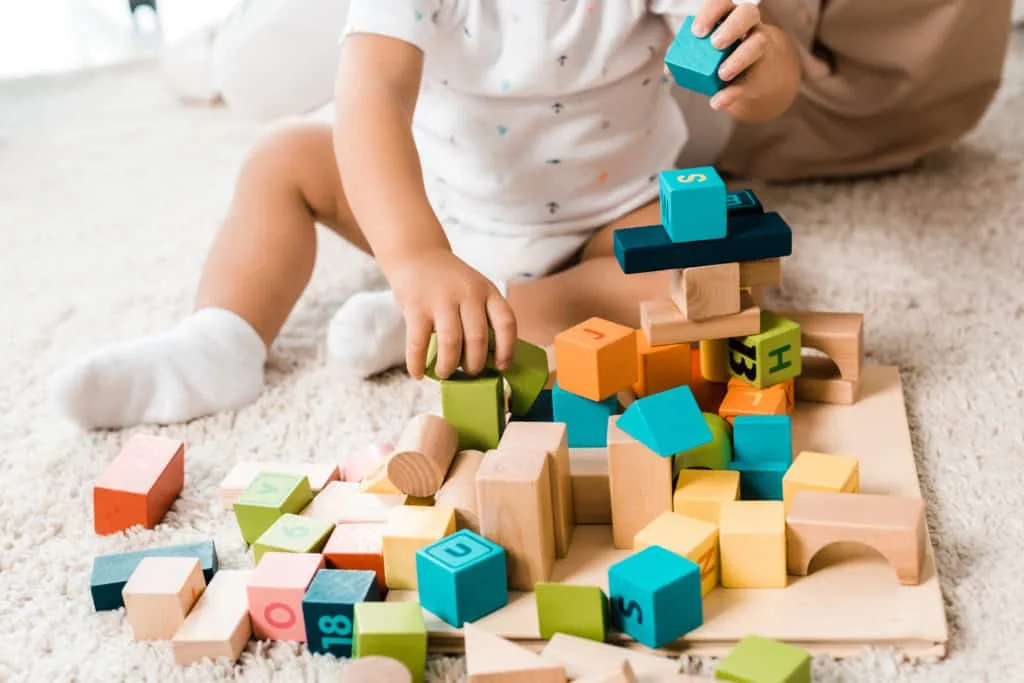
Stacking Activities
Using blocks (like these) to practice stacking is a great option but really you can practice these skills using just about anything. Get creative!
Grab tupperware containers from the kitchen and build towers with them.
Your toddler will love knocking those over!
Save up empty boxes and food containers for stacking as well.
You can encourage early literacy skills by looking at the pictures and words on the boxes while you build.
You can model how to build simple towers or trains for simple imitation practice.
12-24 Months Gross Motor Development
Large motor development can look very different from one child to the next in 12-24 months.
Some may be starting to hit their walking milestones or some may still be crawling.
Your child will strengthen and gain coordination this year allowing them to participate in active play outside and inside.
- Walks without support
- Throws ball forward
- Pulls toys behind them while walking
- Walks upstairs holding railing
- Carries large toys while walking
- Uses ride on toys that they can push with feet
- Squats in play
Gross Motor Activities for 1 Year Olds
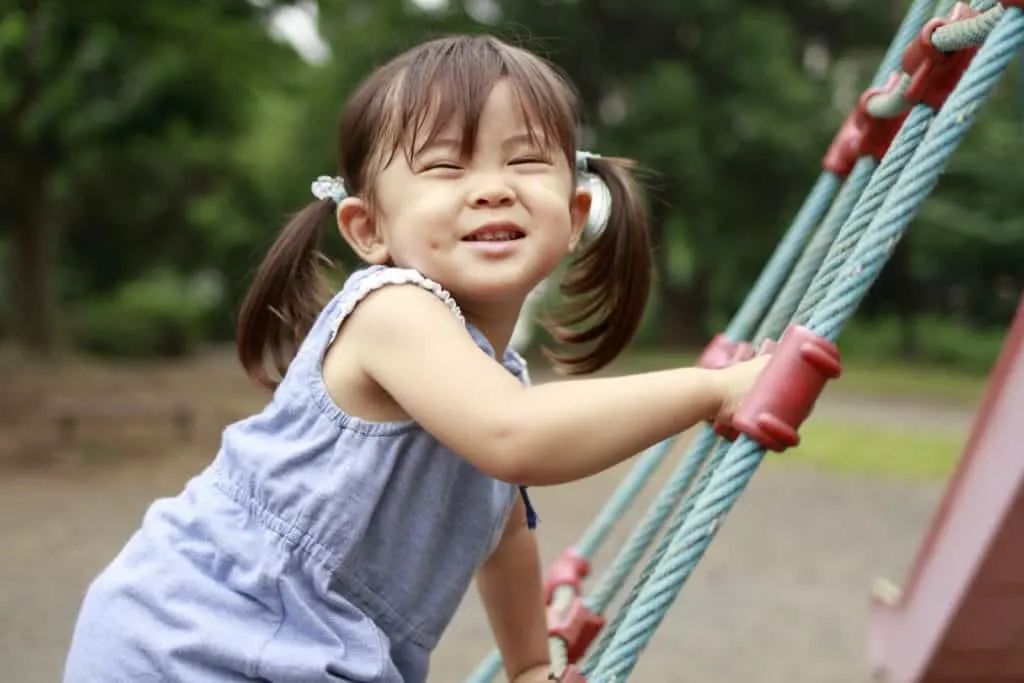
Dance to Music Together
Turn some music on and just move your body!
Watch your little one and see if they try to imitate what you are doing. You can also have fun with it by imitating what they do.
Need tunes? Grab some HERE.
Make an Obstacle Course
Get some things around the house to create an obstacle course for your toddler.
- Put couch cushions on the floor for a fun bridge
- Use painter’s tape on the floor for a balance beam
- Put pillows on the floor to jump on
- Get creative
- Use a crawling mat for a different surface
Get Outside
One of the best ways to work on gross motor skills is to just get outside and explore!
Let your child experience different surfaces for walking such as grass or sand.
Get to a park or playground and explore it together.
Help them climb on the equipment and swing on the swings.
Here are some more ideas on how to encourage development while playing at the park.
12-24 Months Language Development
If your little one hasn’t said their first words yet…chances are they will start speaking soon.
Language development in early childhood is usually broken down into two sets of skills:
Receptive Language: The understanding of words.
Expressive Language: Using words to express wants and needs.
This year your child will start using single words which will then lead to short phrases and sentences.
They will also continue to sharpen their listening skills by following simple directions during play and while participating in daily activities.
- Uses single word sentences
- Gestures to indicate needs
- Attempts to sing sounds to music
- Uses 10-15 words
- Imitates environmental sounds
- Imitates 2-word phrases
- Uses nouns, verbs, and modifiers
- You can understand their words 65% of the time
- Uses their own name
- Makes sounds and jabbers during play
Language Activities for 1 Year Olds
Play Telephone
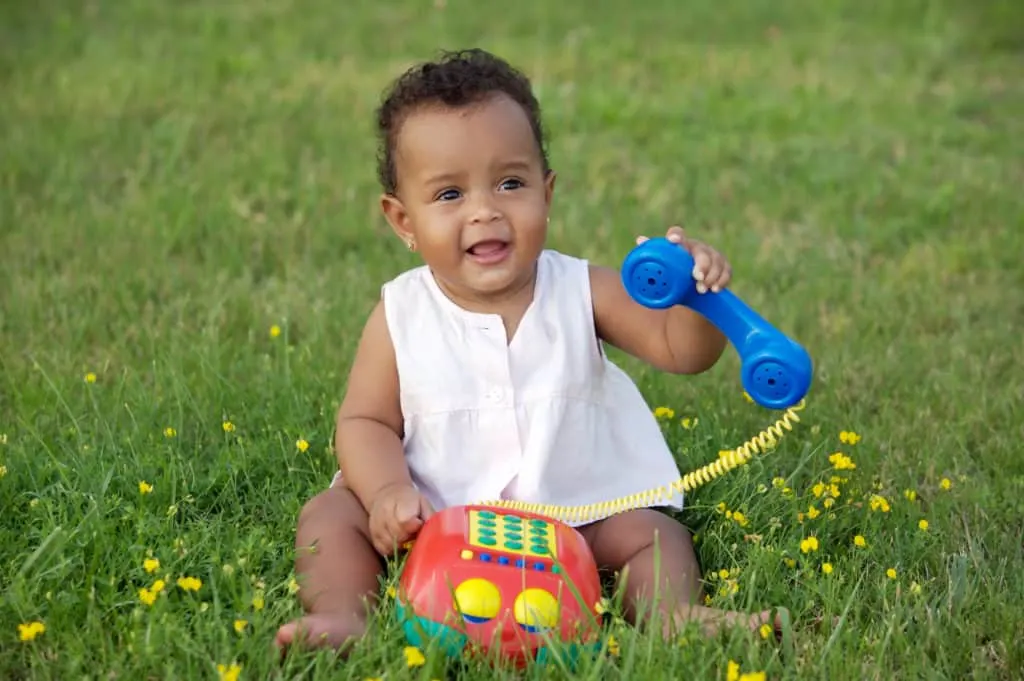
This fun way to pretend is perfect to encourage language development!
You can use a play phone (like this) or just pretend with your hands…or a block!
Practice saying “hello” and “good-bye”. If they babble and jabber with you acknowledge what they are “saying”.
Introduce them to new words by talking about what you are going to do that day or what you did yesterday.
Sing Songs Together
Singing with your little one is one of the BEST ways to encourage language skills.
It allows for natural word repetition which is essential for learning new vocabulary.
Simple nursery rhymes or finger plays are a great way to entertain your toddler during diaper changes as well.
When you introduce a new finger play to your child model it for them first.
Then see if they will let you take their hands and show them how to do it with hand-over-hand guidance.
If not that is ok! By watching you they will learn how to do the actions on their own.
Blow Bubbles
Blowing bubbles is a great way to encourage language development for a few different reasons.
It is an activity that provides LOTS of imitation practice.
Show your little one how to blow a bubble and let them try.
It will probably take them a little practice to be able to blow a bubble as you do.
You can also work on the imitation of simple words and sounds.
Try to use the target words strategy by picking a few simple words to work on when you are playing with bubbles such as “pop”.
12-24 Months Self Help Development
Self help skills are those needed to become independent in daily routines.
These skills are usually evident while your child starts eating and drinking unassisted and starting to take on and off their clothes.
Early signs of potty training may be starting as well.
- May refuse foods
- Holds cup with handle
- Removes socks
- Distinguishes between edible and non-edible objects
- Washes and dries hands with help
- Gives up bottle
- Delays bedtime by making demands
- Helps with simple household chores
- Unzips large zipper
- Plays with food
Self Help Activities for 1 Year Olds
Make a Pouring Station
Little ones love to dump and pour! This is a skill that requires lots of control and refines small motor skills.
Grab a few different containers and either bring them outside or to a place where you don’t mind getting wet.
Let your little one spend time pouring water from one container to another.
You can add ice cubes to make this activity more fun.
To add another layer to the activity you can add food coloring to the water and combine primary colors to make new ones. The options are endless!
Play Dress Up
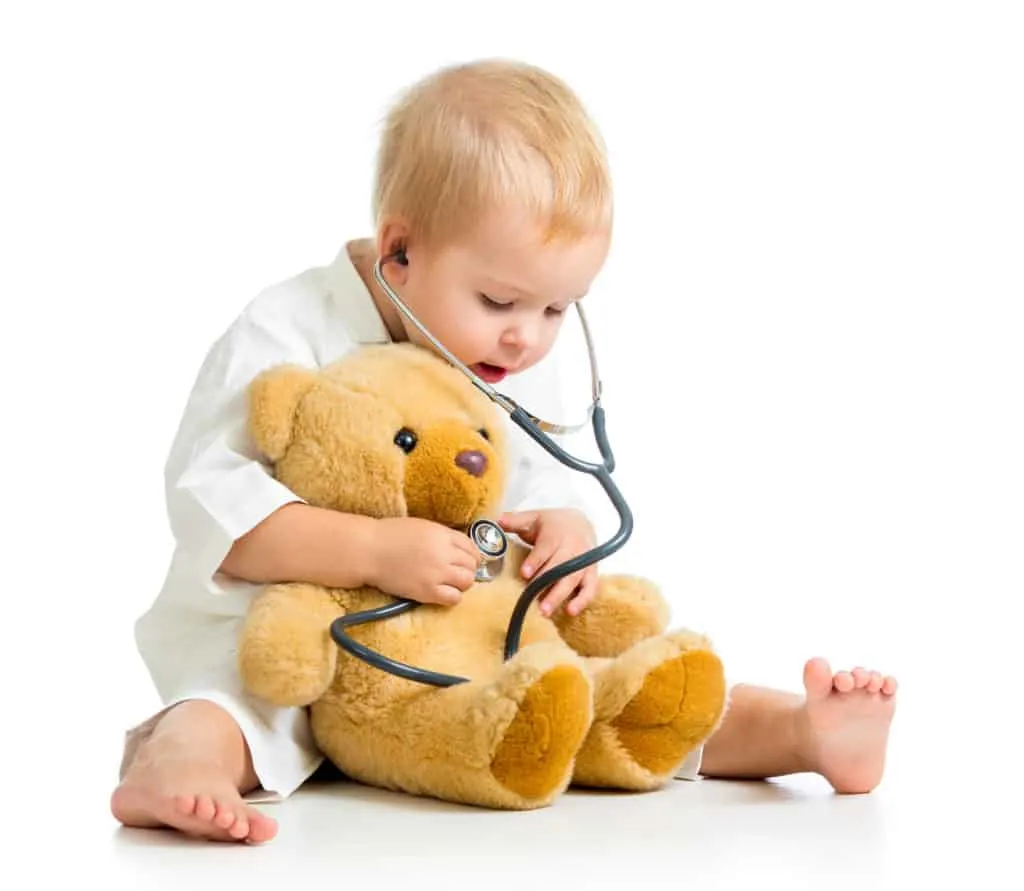
Learning to get dressed is a skill that toddlers start to work on after turning one.
This routine is one that is easily rushed due to time constraints.
Sometimes we are trying to get out the door or trying to get them to bed on time and don’t give them the opportunity to try and put on clothes themselves.
Playing dress up allows you to work on all those skills without time constraints.
Grab a bag of clothes (preferably ones that are too big) and enjoy putting on silly outfits.
Make sure to take them over to the mirror to see what they look like.
Helping with Chores
You don’t need to save all of your housework for when your toddler is sleeping.
Include them in the chores that you need to get done throughout the day to help them learn.
There are lots of benefits to letting toddlers help with chores (read about them here.)
You can learn about colors as you fold the laundry. Give them their own pile to “fold” as they try to imitate you.
Give them their own washcloth to help wipe down tables or windows.
Have them help you sweep the floor or vacuum.
Child sized cleaning tools (this is the set we have) can become a favorite!
This also a great age to encourage them to pick up toys when they are done playing with them.
Have them help you gather toys and put them in the toy box when it is time to clean up.
Don’t expect them to be proficient at this any time soon…it will take lots of practice so just be patient.
Take Them on Field Trips
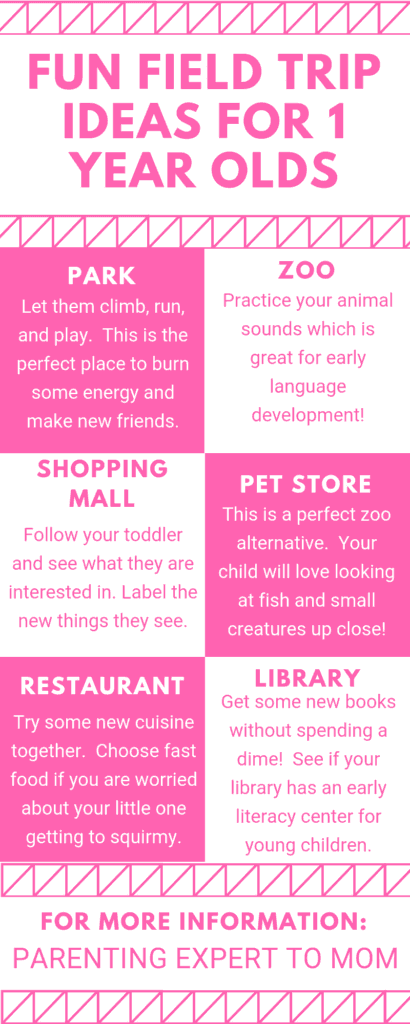
Getting out of the house and outside is a great way to encourage your little one to explore.
If you feel overwhelmed when you take your toddler out that is ok.
Start small and try short simple errands if you have a difficult time taking your toddler out.
As you and your child feel more confident going to new places look around your community to see where you can go together.
Here are some examples of places you and your toddler will enjoy:
- Zoo
- Playground
- Park
- Shopping Mall
- Restaurant
- Children’s Museum
- Library
- Pet Store
Book Activities for 1-Year-Olds
When sitting down for story time with your little one there are many ways to look at books depending on your little one’s developmental level.
Don’t be concerned if your toddler is too busy to sit and “read” books with you.
Focus on just the naming and pointing at pictures to start.
Let them take the lead sometimes and see where their interest lies.
Maybe they just like to flip through the pages fast.
You can find more reading tips for busy toddlers here.
Do they have a certain picture that they like to look at?
Pick books that our toddler is interested in and will be motivated to look at.
Where can I find the best activities for my 1-year-old?
One of my favorite ways to keep little ones busy is by including them in daily chores and routines.
Often times we try to keep our children occupied with something else while we try to get a task done.
However, when we include them and are mindful of what we are doing we can teach them while getting things done around the house.
If you would like to get ideas and strategies on how to do this then you should check out my inspire learning calendars.
These calendars will give you some inspiration when coming up with ideas for activities.
Best Toys for 1-Year-Old Activities
Puzzles (like these) can be a great way to work on language skills, fine motor, and problem-solving skills.
There are a variety of different kinds to get depending on your child’s skill level.
Start out with bigger and fewer pieces moving on to more difficult puzzles as they become easier for your child.
Play Dough that you buy in the store or make from home provides a play option that gives sensory input and allows for imaginary play.
Let your child explore the dough with their hands and see how they react.
Do they love it?
Do they want to wash their hands right away?
Some children love this type of sensory play while others may not.
Watch their cues and follow your child’s lead.
Musical toys (like these) are fun for your little musician.
Model for your child how to use them and then have fun making music together!
If you are looking to encourage gross motor skills as your toddler learns to walk a push/ride on toy (like this) can be a great choice.
Your toddler will have fun pushing it around and then riding it as they gain coordination.
This is a great outdoor toy and if you have the space indoors you can incorporate it there as well.
Safety Tips for 1 Year Old Activities
There are a few things you want to keep in mind when preparing activities for your child.
If your toddler is still putting non-food items in their mouth be careful with doing activities with smaller pieces.
You may want to avoid those activities altogether until there is no longer a choking hazard.
Toys or cotton balls that are used for sorting are often too small for little ones that still put toys in their mouth.
You can use a food alternative (such as fruit loops) to still work on the skill if you would like.
Another safety measure to keep in mind is that children over a year are still gaining balance and strength.
Make sure to supervise them while they are playing and give them support with their gross motor skills as needed.
Always childproof the areas where your child spends time and closely supervise.
They can quickly get into unlocked cupboards and climb to reach things of interest as well.
Most Important: Have fun!
When playing with your toddler the most important thing is to just HAVE FUN and ENJOY them.
They will pick up skills throughout activities and play as long as they are given the opportunity to participate.
Get creative and become a child yourself. Look through their eyes and you will come up with lots of ideas of what to do.
Exploring new places and getting outside are simple ways to allow your child to experience new environments and learn about information.
If you enjoyed this post make sure you follow on Instagram for daily tips and videos!
Related Posts You Will Enjoy
5 Ways to Promote Positive Behavior in Toddlers
Screen Free Parenting: 10 Things to Have Your Toddler Watch Instead of TV
Fun Toddler Bath Toys that Encourage Development
Top Non-Toy Gifts for Toddlers
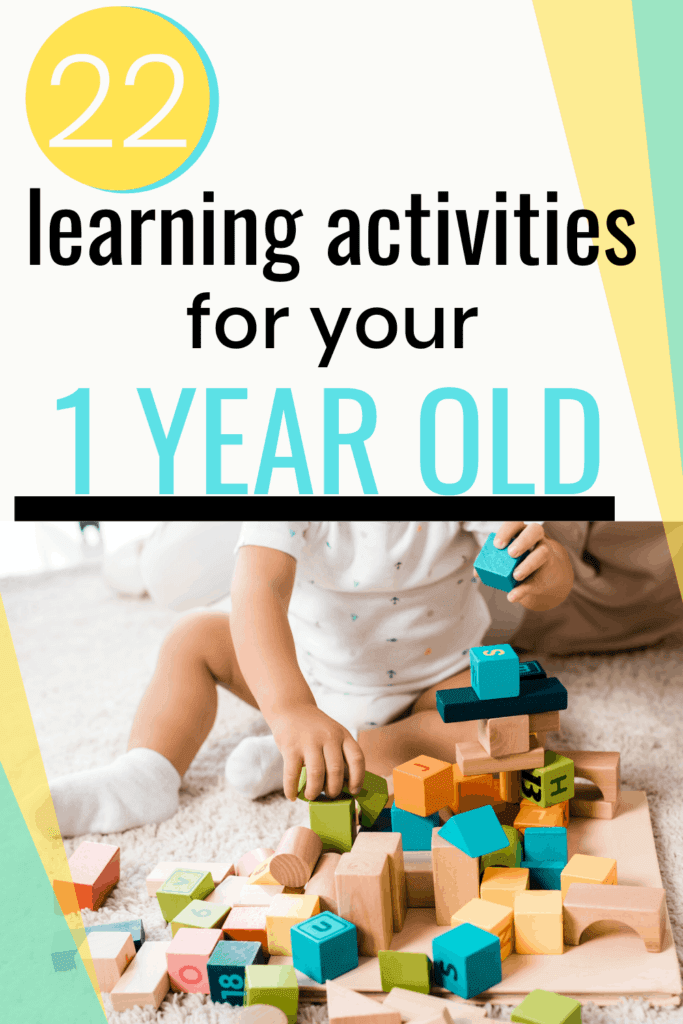
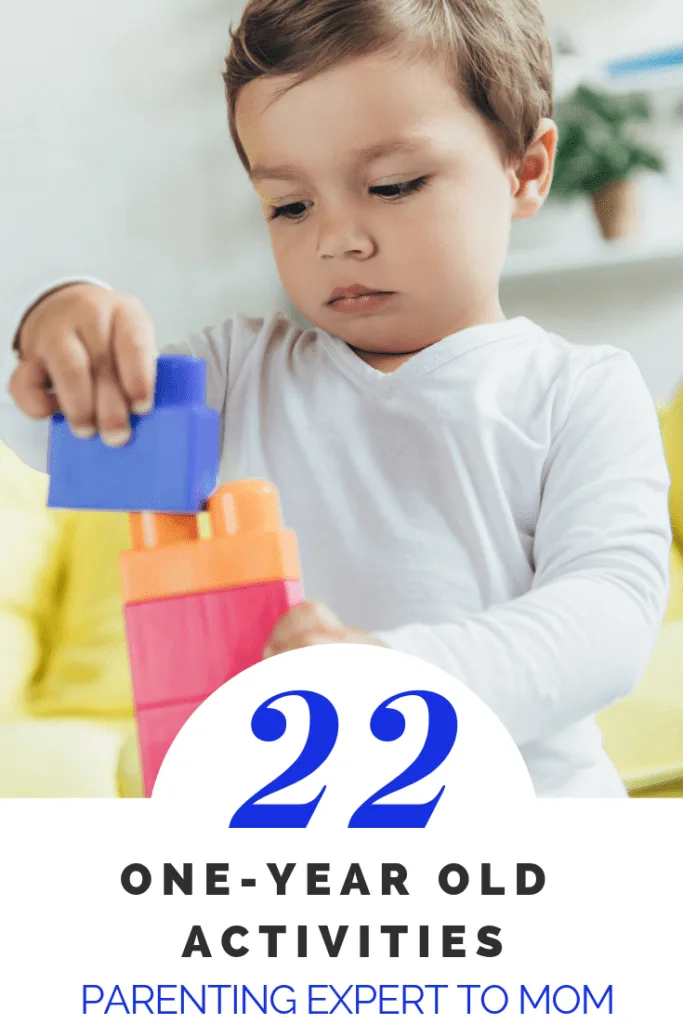

Kayla O’Neill has a master’s degree in education as well as a bachelor’s degree in special education with an emphasis in early childhood education. She has been working as a developmental therapist with babies and toddlers in early intervention since 2012. She is also a mom with two young children.
